Reviews Continuous Flow Pulse Oxygen Concentrators Portable
Updated: October 30, 2019
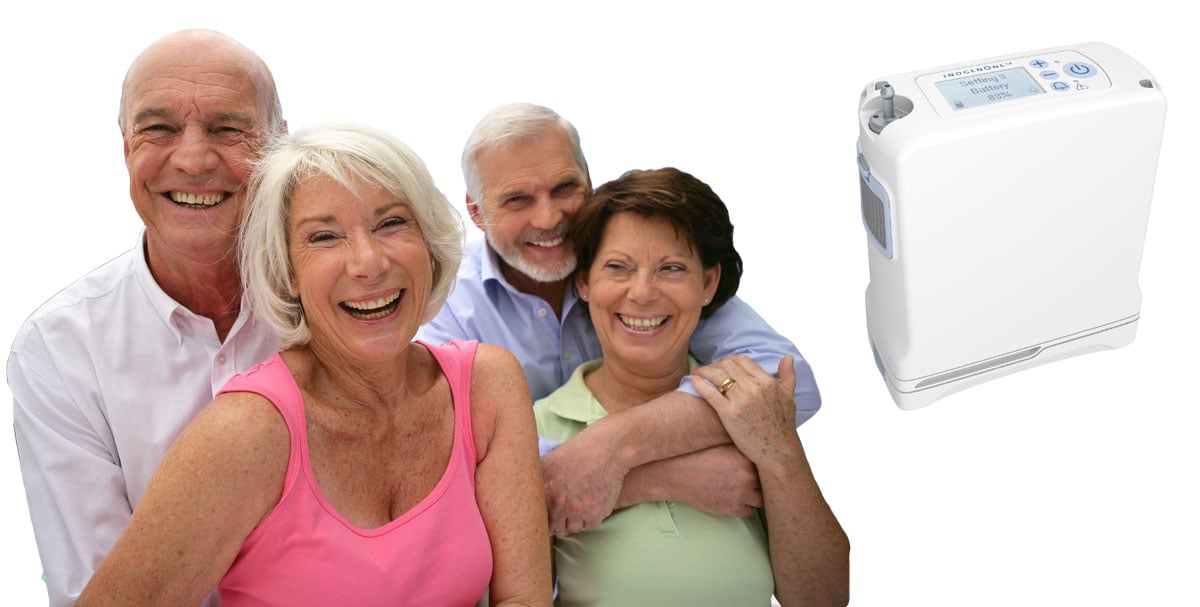
Review Pulse Flow Portable Oxygen Concentrators with Comparison Chart - 2020
Portable Oxygen Concentrators offer oxygen therapy for patients who live active lifestyles. Portable oxygen concentrators come in two basic types--pulse flow and a combination of pulse flow and continuous flow oxygen. A pulse flow concentrator provides puffs of oxygen when the patient inhales. A continuous-flow concentrator provides oxygen regardless of whether the oxygen patient is inhaling or exhaling. Many oxygen patients find that pulse flow is more comfortable because they do not have to fight against incoming oxygen when they are exhaling. Patients that need continuous flow oxygen often like the ability to switch between the two oxygen flows, using continuous-flow when they feel they are not getting enough oxygen and using pulse-flow at all other times.
Portable oxygen concentrators that provide continuous flow, as well as pulse flow, can be viewed at this link - Continuous Flow Portable Oxygen Concentrators along with comparison charts and reviews at Review Portable Oxygen Concentrators with Continuous Flow.
For the purposes of this concentrator review, we will examine only the top pulse flow portable oxygen concentrators. Sometimes these oxygen concentrators are referred to as "Carry-Concentrators" because of their small size and low weight. The combination of small size and low weight make these oxygen concentrators easy to carry in a small shoulder bag or backpack wherever the oxygen patient wants to go. Many oxygen patients find that they like the independence and freedom that these smaller oxygen concentrators offer.
Since Pulse Flow Portable Oxygen Concentrators are smaller machines, they generate more modest amounts of oxygen. They are, therefore, not the right choice for oxygen patients who require larger doses of oxygen. Generally, the pulse dose oxygen machines work well for oxygen patients who need two or fewer liters of oxygen per minute (LPM). Since most oxygen patients in the USA require only 2 LPM or less, a portable oxygen concentrator is the right purchase decision for many.
This portable oxygen concentrator review examines the top ten pulse-flow oxygen concentrators on the market that offer at least 2 liters of oxygen therapy per minute or equivalent. These concentrators include the FreeStyle 5 from AirSep, the G3, G4, and G5 from Inogen, the EasyPulse POC-5 from Precision Medical, Invacare Platinum Mobile, Zen-O Lite by GCE, FreeStyle Comfort from Caire, DeVilbiss iGo2, Respironics SimplyGo Mini, O2 Concepts Oxlife Freedom, and the ResMed Mobi. A side-by-side comparison of the Top Ten Portable Oxygen Concentrators - Pulse Flow is provided below this review.
Additional oxygen concentrator reviews, rankings, and comparison charts are available by clicking on the links below:
- Portable Oxygen Concentrator Reviews by brand.
- Ranking the Continuous/Pulse Flow Portable Concentrators - rank orders the top concentrators that offer pulse and continuous flow oxygen.
- Airline Travel with an FAA Approved Portable Oxygen Concentrator.
- Choosing a Travel Concentrator or portable oxygen machine for airline travel.
- What is a Continuous Flow Portable Oxygen Concentrator?
- What is a Pulse Flow Oxygen Concentrator?
- High Flow Oxygen Concentrator Review - examines 8- and 10-liter oxygen generators.
- Ranking the Low Flow Oxygen Concentrators - compares O2 machines for home use that offer 3-liters or less.
- Home Oxygen Concentrator Rankings - a comparison of the top ten home oxygen concentrators with 5-liters of oxygen output.
Ranking the Top Twelve Portable Concentrators by Size and Weight
Size and weight are two of the most important factors to consider in selecting a portable oxygen concentrator, particularly if you are carrying your oxygen concentrator with you. Just a few pounds can quickly become a heavy burden--a few inches bigger means bumping into more walls, doorways, and furniture. Small, lightweight oxygen concentrators are essential for day-to-day use away from home.
The smallest, lightweight oxygen concentrators are manufactured by Inogen One. All three of their models are the smallest size and lowest weight in this product category. The #1 ranking portable concentrator for size and weight is the Inogen G4. Weighing less than 3 pounds and occupying less than 100 cubic inches, the G4 is in a class of its own. Its closest competitors are from the same manufacturer--Inogen One.
Contrasting the number 1 and the next two lightweight/small size concentrators, the G4 is less than half the size of both the G3 and G5 concentrators. The G4 weighs a half-pound less than the G5 and 1-pound less than the G3, making the G4 the easiest to carry with you anywhere you choose to go. The remaining concentrators are larger and heavier to take along with you. The Mobi is the largest portable in the group with nearly 343 cubic inches. The EasyPulse is heaviest at 6.6 pounds.
The chart below ranks the top twelve portable oxygen concentrators by weight and size.
Size Comparison Chart

As shown in the chart above, the Inogen One G4 is on the far left-bottom of the chart with the smallest bubble size and the closest bubble to the bottom of the chart, representing that it is the smallest size portable concentrator. The ResMed Mobi has the largest bubble and the highest position along the "Size" axis, representing the largest size concentrator. The larger the bubble size and the higher the bubble placement on the graph, the bigger the concentrator's size.
Concentrator weight on this chart displays on the horizontal axis. The G4 displays at the far left of the graph between 2.5 and 3 pounds, while the EasyPulse is at the far right hovering short of the 7-pound marker. The farther the bubble appears on the right of the graph, the heavier the concentrator. The machines to the left of the chart are the most lightweight.
The average size portable concentrator is 256 cubic inches indicated by the horizontal red line across the graph. The Inogen G3, G4, G5, iGo2, and the FreeStyle Comfort all have smaller sizes better than average. The average weight is 4.5 pounds, indicated by the red, vertical line on the graph. Six concentrators have less than average weight and therefore display to the left of the red, verticle line. The other six machines fall to the right of the verticle red line, indicating more than average weight. For oxygen patients requiring a small, lightweight concentrator as their top concern, the G4 is their best choice.
The next chart displays the total weight of the concentrators when adding their most lightweight battery version and their carry bag. The blue columns represent the machine weight, the red column stacked above the blue column represents the single battery weight, and the yellow columns stacked above the red columns represent the weight of the carry bag. A total carry-weight for the patient displays above the aggerate of the three colored columns. The red horizontal line represents the average total carry-weight. Eight concentrators are below the red line or are better than average for total weight, while five portable concentrators are at or above the average total weight. The #1 ranked concentrator on this comparison is the G4 with a total carry weight of 3.5 pounds. This weight is less than half of the three heaviest concentrators--Mobi, FreeStyle 5, and EasyPulse.
The chart below ranks the top twelve portable oxygen concentrators by their combined machine, battery, and carry bag weight.
Machine Weight Comparison

Power Source
Each of the top twelve portable oxygen concentrators is travel-ready to foreign countries. All of them have adaptable power requirements ranging between at least 100 to 240 VAC and 50-60 Hz that allow you to operate the concentrator almost anywhere as well as recharge the battery. Each of these concentrators can power by direct current from an automobile or recreation vehicle. These portable O2 devices can also operate from a battery power source.
This concentrator review will examine two important factors that bear on how long these portable oxygen concentrators can sustain operation under their standard battery power source. These two factors are 1) the power consumption of the oxygen generator and 2) the battery duration between charging. Each of these concentrators uses a proprietary lithium-ion battery to operate upon while away from an external power source. These concentrators come with a rechargeable lithium-ion battery that you will not be able to replace or supplement by going to a local retailer like Target or Walmart. However, each of the manufacturers offers additional batteries for purchase as a replacement or to complement your initial concentrator purchase.
Power Consumption
The G5 uses the least amount of power to operate at only 18.7 watts per hour. The Platinum Mobile and the Zen-O Lite follow closely behind, at 24 and 25 watts, respectively. The average watt usage for this group of O2 machines is 128 when operating at setting 2. Four of the concentrators operate at an average of 120 watts. Two devices consume power above the norm.
The chart below displays a comparison of the pulse flow concentrators by rank for power consumption. The red horizontal line shows the average watt usage at 128 watts per hour while operating at setting 2. The concentrators below the red line have better than average power consumption, while the ones above the line have more significant power requirements than the average.
The "power-hog" concentrator that uses the most power to work is the AirSep FreeStyle 5 with a 240-watt power requirement. That is more than 12 times the power requirement of the G5. ResMed does not provide the average power requirements for the Mobi.
Power consumption at home is usually not a significant factor for portable oxygen concentrators since they employ small motors to facilitate easier travel. However, since portable oxygen concentrators most often are operating off of their internal battery power, low power consumption will generally allow the battery to power the concentrator for a more extended period. Longer operating times while in portable mode is very important to oxygen therapy patients. Lower power requirements can translate into longer battery time before having to recharge, providing longer excursions away from external power sources. No one wants to tether to an external power source for very long or very often.
In the comparison chart below, most of the concentrators have better than average power consumption. Two concentrators use more power than average to operate.
Power Consumption Comparison Chart
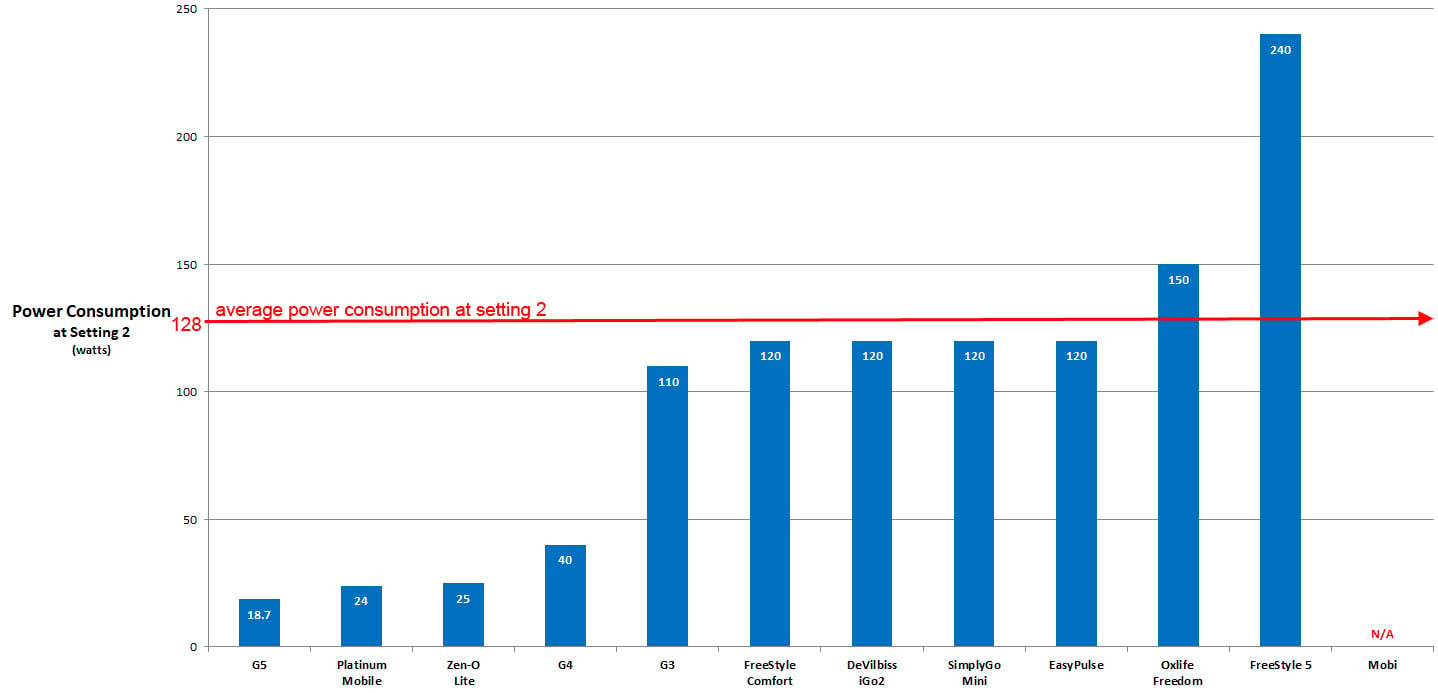
Battery Capacity
The battery capacity is another essential consideration. This figure will tell how long you can operate your concentrator while away from an external power source. Even though each of these concentrators come from the manufacturer with at least one lithium-ion battery, these batteries are significantly different in size and capacity. Finding a portable concentrator with a small, lightweight battery able to power your concentrator for an extended time while only requiring a short time to recharge is ideal.
The highest battery capacity is the Mobi at 6-hours. Ranking #2 for battery capacity at 4.5-hours is the SimplyGo Mini, followed by a four-way tie at 4-hours for the FreeStyle Comfort, Oxlife Freedom, G3, and the Zen-O Lite.
The chart below displays the rank order for battery capacity while using the concentrator on setting 2. The concentrators with the best battery times are on the left, while the concentrators with less battery time are on the right. The standard battery capacity displays in blue while the extra-capacity or double battery (marked with and "D" on the graph) or external battery (marked with an "X") displays in red. Usually, the extra-capacity or external battery sells as an accessory item. The red horizontal line at 3.7 hours indicates the average battery capacity. The total battery duration, including the standard battery and the extra-capacity or external battery, displays at the top of each column.
Battery Capacity Comparison Chart
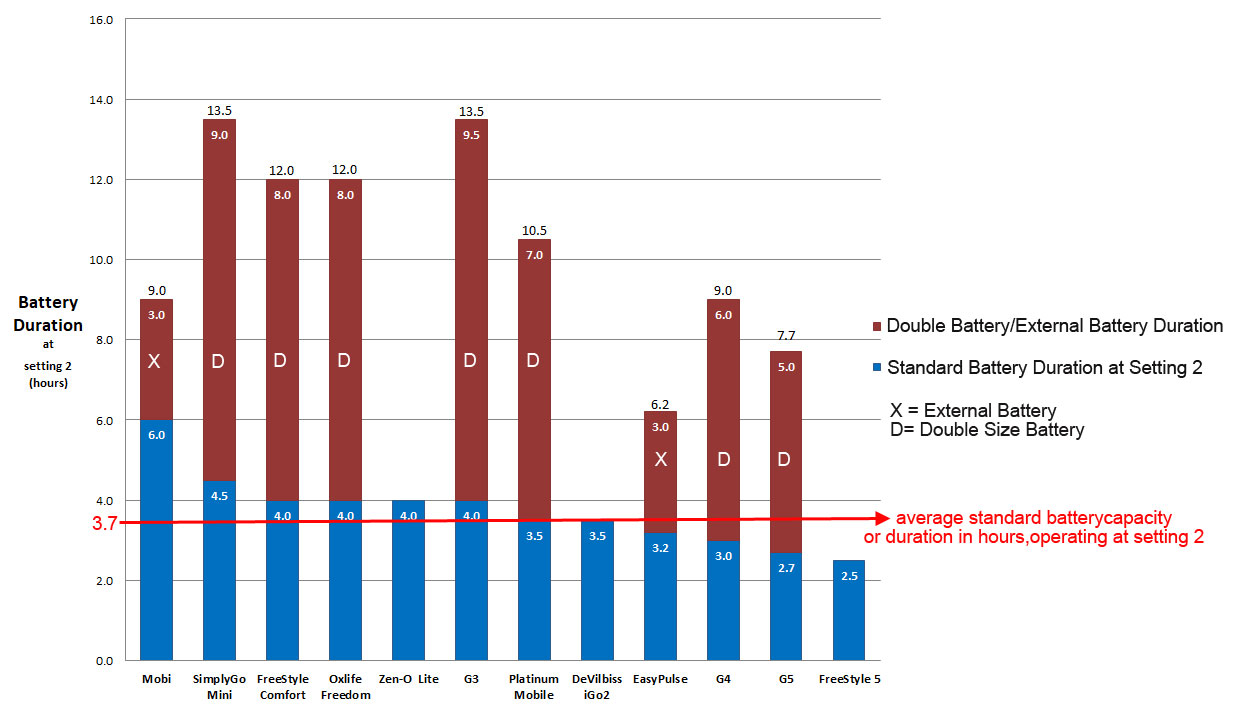
The #1 ranked oxygen machine for battery capacity is the Mobi with 6-hour battery life while operating at setting 2. The SimplyGo Mini and the G3 have a battery life of 13.5 hours when combined with their extra-capacity battery. The lowest battery capacity is FreeStyle 5, with only 2.5 hours.
Six concentrators have a battery capacity above average--Mobi, SimplyGo Mini, FreeStyle Comfort, Oxlife Freedom, Zen-O Lite, and G3. The other six concentrators provide a standard battery below the average capacity.
Battery Recharge Time
The chart below displays the amount of time it takes to recharge the standard battery that accompanies the sale of the concentrator. Each column represents the amount of recharge time required with the actual amount of hours for recharging indicated at the top of the column. The red horizontal line depicts the average number of hours to recharge at 3.4 hours. Six concentrator batteries require less than average time to recharge while the other six take more time than average.
Battery Charging Comparison Chart

The fastest charging battery is the Platinum Mobile, requiring only 2.3 hours. Ranking #2 is a 3-way tie between the Oxlife Freedom, G5, and Zen-O Lite, each requiring 3 hours to recharge.
The next chart below compares the standard battery capacity side-by-side with the amount of recharge time. Red horizontal lines display the average battery capacity in hours, and the average recharge time in hours. Four machines produce some concern about the length of time needed for recharging. These four machine batteries require more time to recharge than they provide in operating time. These machines are the iGo2, the G4, G5, and FreeStyle 5. Oxygen patients that are always on the go may want to stock up on batteries and purchase an external battery charger if they are buying one of these four machines.
Battery Capacity vs. Battery Charging Comparison
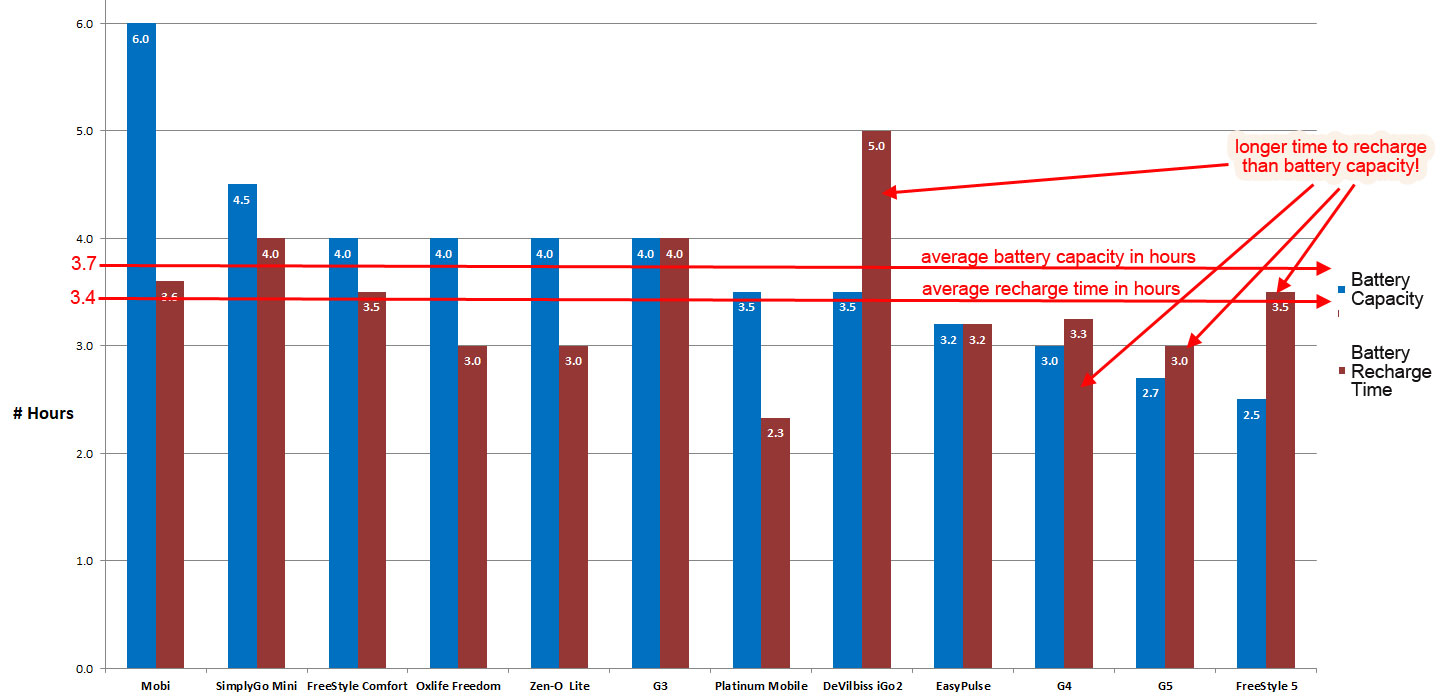
Best Performing Pulse Oxygen Concentrator
The most important feature to rank is the performance of the portable oxygen concentrator. Having the most lightweight concentrator with the most extended power duration does little good if it is unable to provide sufficient oxygen to the patient. If a patient requires 10 liters of continuous flow oxygen per minute, none of these portable oxygen concentrators will be adequate. In evaluating concentrator performance, we examined the maximum minute volume flow, the oxygen concentration output, the maximum outlet pressure, and the operating altitude in feet above sea level for each machine. These four measurements provide an excellent analysis of the oxygen output capacity of each of these portable oxygen machines.
The #1 ranking portable oxygen concentrator for performance is the Inogen G5. It provides the highest minute flow volume at 1260 mL per minute (mL PM), the highest oxygen concentration level of 87 to 96% (tied with five other machines), the fourth-best outlet pressure at 28.9 psi, all while using the least amount of power to do so. The G5 can operate at altitudes up to 10,000 feet above sea level.
The comparison chart below displays the four factors considered and the measurement for each concentrator.
| Rank | Model | Pulse Oxygen Flow (max minute volume mL) | Oxygen Concentration | Oxygen Outlet Pressure (max psi) | Operating Altitude (feet above sea level) |
| 1 | Inogen G5 | 1260 | 87 to 96% | 28.9 | 0 - 10,000 |
| 2 | FreeStyle Comfort | 1050 | 87 to 95% | 30 | -1,250 - 10,000 |
| 3 | Zen-O Lite | 1050 | 87 to 96% | 25 | 0 - 13,000 |
| 4 | DeVilbiss iGo2 | 1014 | 87 to 94% | 24 | 0 - 10,000 |
| 5 | SimplyGo Mini | 1000 | 87 to 96% | 20 | 0 - 10,000 |
| 6 | FreeStyle 5 | 963 | 87 to 95.5% | ~30 | 0 - 12,000 |
| 7 | Platinum Mobile | 880 | 87 to 95.6% | 28.5 | 0 - 10,000 |
| 8 | Inogen G3 | 840 | 87 to 96% | 25 | 0 - 10,000 |
| 9 | EasyPulse | 780 | 87 to 95% | N/A | 0 - 9,000 |
| 10 | Inogen G4 | 630 | 87 to 96% | 20 | 0 - 10,000 |
| 11 | Oxlife Freedom | 96 | 87 to 95% | 19.9 | 0 - 13,123 |
| 12 | ResMed Mobi | 45.7 | 87 to 96% | 29 | 0 - 10,000 |
Lowest Noise
Oxygen patients do not like to draw attention to the fact that they require oxygen therapy. A loud oxygen concentrator signals to anyone nearby that you have a respiratory disability. Finding an unobtrusive, quiet concentrator is the objective of most buyers. All of the top twelve pulse-flow POC's emit low levels of noise. All but one of the concentrators emit noise in the safe, comfortable sound zone established by OSHA. Fifty decibels and lower constitutes the "Safe and Comfortable Sound" as designated by the Occupational Safety and Health Administration (OSHA). Eleven of these portable oxygen concentrators fall in this comfort zone. The noise range for these eleven O2 machines is 38 to 43 decibels.
The loudest machine is the Oxlife Freedom at 50 to 52 decibels, rated in the "Non-Hazardous Sound" zone, below the sound of human conversation, which averages 60 decibels. The concentrator emitting the least noise is the Zen-O Lite at 38 decibels. The Mobi is close behind at 38.2 decibels. As a comparison, a standard refrigerator in your home emits 30 decibels. On the decibel chart below, the lowest noise and the highest noise concentrators display along the safe and non-hazardous sound meter.
Lowest Noise Comparison
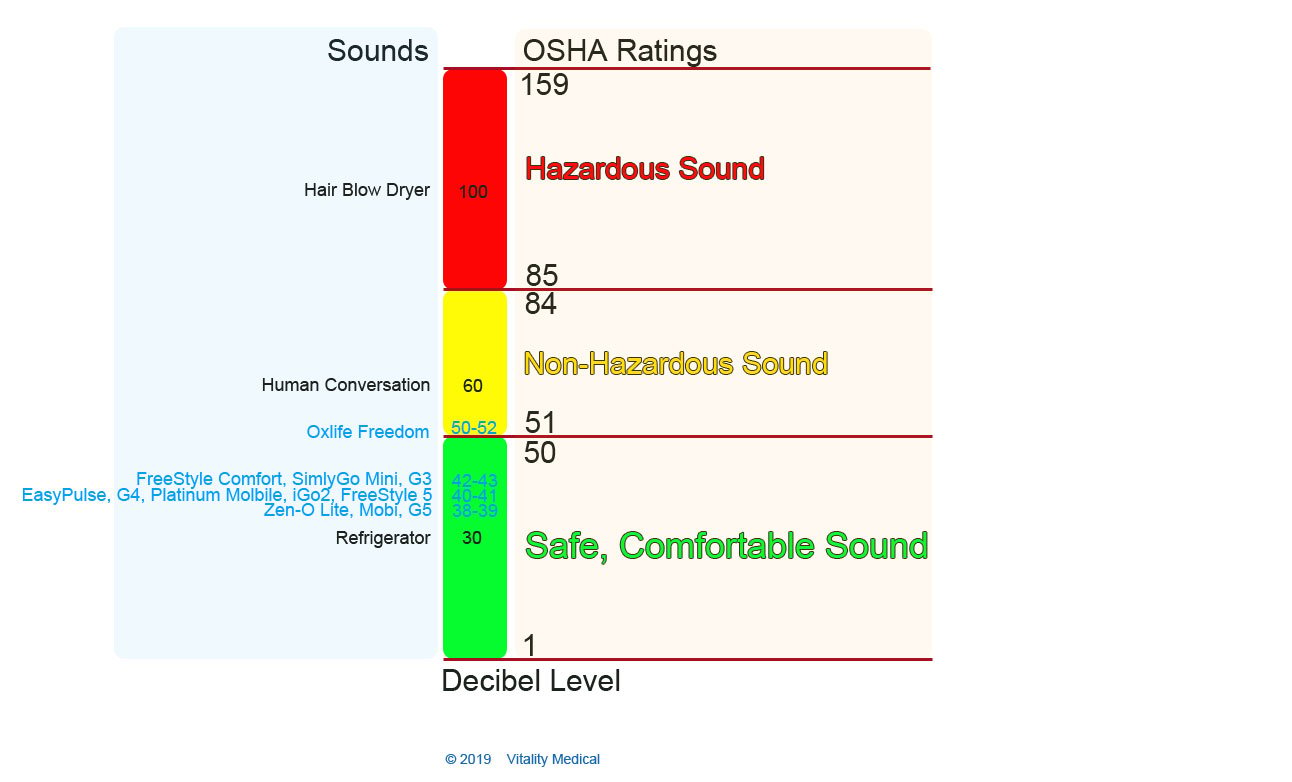
24/7 Operation
The ability of an O2 machine to provide 24/7 operation is vital for some oxygen patient travelers. Some patients who travel and are away from their Home Oxygen Concentrator for a short duration need their oxygen day and night. When travelers return to their hotel at night, there is no home oxygen concentrator available for use. These travelers must rely on their portable oxygen concentrator 24/7 while away from home. Only three of the twelve pulse-flow oxygen concentrators offer 24/7 operation as designated by their manufacturer. These concentrators are the Inogen One G3, G4, and G5.
Vitality Medical does not recommend using these three machines for 24/7 operation while at home. These oxygen generators are expensive, and unnecessary wear and tear on the devices will occur with continuous service. It is more economical to use a home oxygen concentrator while at home, saving your more expensive portable concentrator for travel situations. Mobile O2 devices with 24/7 capability may accommodate vacations of a few week's duration.
Best Selling Portable Concentrators
The #1 best selling portable oxygen concentrator at Vitality Medical is the Inogen G4. It is the concentrator with the smallest profile and lowest weight. Close behind in second place is the G3. The G3 model is well known and often recommended by physicians. The #3 ranked best selling concentrator is FreeStyle 5. The EasyPulse comes in at fourth.
Overall Best Portable Oxygen Concentrator Pulse Flow
The overall best portable oxygen concentrator is the Inogen G5 Oxygen Concentrator. This concentrator has the highest oxygen flow, highest oxygen concentration level (tied with four others), high outlet pressure, and the lowest power consumption. This machine also ranks high for small size, low weight, and offers 24/7 operation. Oxygen patients with a primary concern of machine performance will make a wise choice with the Inogen One G5.
The second best pulse-flow oxygen concentrator is the G4, the sister unit to the G5. This model ranks #1 for the smallest size, #1 for the lowest weight machine, and #1 for the lowest carry weight (machine, battery, and carry bag weight). Oxygen patients focused upon the most comfortable machine to carry along with them will want to consider the G4 seriously.
The next best portable oxygen concentrator is the Zen-O Lite from GCE Group. This device ties for first for oxygen concentration level, ties for second for maximum oxygen flow, places third for low power consumption, ties for second in shortest battery recharging time, and is second for highest operating altitude.
Other noteworthy O2 machines to point out are the long warranty periods offered by the DeVilbiss iGo2 and the ResMed Mobi at five years. The Zen-O Lite offers the lowest noise level, short battery recharge time, and low power consumption. The Invacare Platinum Mobile provides the lowest battery recharge time and second-lowest power consumption.
Best Pulse Flow Portable Oxygen Concentrator
Pulse Flow Portable Oxygen Concentrator Comparison Chart - 2020
| Pulse Flow Concentrators |  |  |  |  |  |  |  |  |  |  |  |  |
| Model | Inogen One G3 | Inogen One G4 | Inogen One G5 | FreeStyle 5 | FreeStyle Comfort | iGo2 | SimplyGo Mini | Platinum Mobile | Oxlife Freedom | Zen-O Lite | EasyPulse POC-5 | Mobi |
| Model # | IS-300-NA | IS-400 | IS-500 | AS200-1 | XPO100 | 306DS | 1113601 | POC1-100C | 800-0003-1V | RS-00608-G-S | PM4150 | 35001 |
| Manufacturer | Inogen | Inogen | Inogen | AirSep | CAIRE | DeVilbiss | Respironics | Invacare | O2 Concepts | GCE Group | Precision Medical | ResMed |
| Performance | ||||||||||||
| Pulse Oxygen Flow (max minute volume mL) | 840 | 630 | 1260 | 963 | 1050 | 1014 | 1000 | 880 | 96 | 1050 | 380 | 45.7 |
| Oxygen Concentration | 87 to 96% | 87 to 96% | 87 to 96% | 87 to 95.5% | 87 to 95.5% | 87 to 94% | 87 to 96% | 87 to 95.6% | 87 to 95% | 87 to 96% | 87 to 95% | 87 to 96% |
| Oxygen Outlet Pressure (max psi) | 25 | 20 | 28.9 | ~30 | 30 | 24 | 20 | 28.5 | 19.9 | 20.5 | N/A | 29 |
| Operating Altitude (feet above sea level) | 0 - 10,000 | 0 - 10,000 | 0 - 10,000 | 0 - 12,000 | -1,250 - 10,000 | 0 - 10,000 | 0 - 10,000 | 0 - 10,000 | 0 - 13,123 | 0 - 13,000 | 0 - 9,000 | 0 - 10,000 |
| Size | ||||||||||||
| Width (inches) | 88 | 2.7 | 3.3 | 6.4 | 3.5 | 9.1 | 8.3 | 7.5 | 9 | 9.8 | 6.5 | 9.6 |
| Height (inches) | 7.3 | 5.9 | 8.2 | 10.5 | 8.4 | 7.9 | 9.4 | 9.45 | 9.4 | 9.1 | 10.1 | 7.95 |
| Depth (inches) | 3 | 5.91 | 7.19 | 4.4 | 8.6 | 4.38 | 3.6 | 3.88 | 3.4 | 3.8 | 4.5 | 4.49 |
| Cubic Size (inches) | 190.3 | 93.6 | 191.03 | 295.7 | 252.8 | 312.2 | 280.9 | 275.0 | 287.6 | 338.88 | 295.43 | 342.68 |
| Weight with Battery and Carry Bag (pounds) | 5.4 (8 cell battery) 6.4 (16 cell battery) | 3.4 (8 cell battery) 4.03 (16 cell battery) | 6.5 (8 cell battery) 7.67 (16 cell battery) | 7.3 | 5.5 | 6.4 (8 cell battery) 7.2 (16 cell battery) | 5.8 (8 cell battery) 8.2 (16 cell battery) | 5.7 (8 cell battery) 8.2 (16 cell battery) | 6.3 (8 cell battery) 7.65 (16 cell battery) | 5.9 (8 cell battery) 6.8 (16 cell battery) | 8.3 (internal battery) 9.7 (external battery) | 7.1 (internal battery) 8.2 (external battery) |
| Operating Factors | ||||||||||||
| Noise (dBA) (On Setting 2) | 42 | 40 | 39 | 41 | 43 | 41 | 42 | 40 | 50 - 52 | 38 | 40 | 38.2 |
| Power Connections | Worldwide Sensing 100-240VAC or 12VDC | 100 to 240 VAC, 50 to 60 Hz, Auto Sensing | 100 to 240 VAC, 50 to 60 Hz, 1 Amp | 100 - 250 VAC, 50.60 Hz, 11-16 VDC | 100 to 240 VAC, 50-60 Hz, 11–18 VDC (10 max amp) | 100-240 VAC, 50/60 Hz, 13.8 to 17 VDC | 110–240 VAC, 50–60 Hz, 11–16 VDC | 110–240 VAC, 50–60 Hz, 11–16 VDC | 110–240 VAC, 50–60 Hz, 11.5–16 VDC 18 Amp | 100-240V AC (+/- 10%) 50-60 Hz, 5 Amp, 11.5 – 16 VDC, 5 Amp | 100 to 240 VAC, 1 Amp 1 - 16 VDC, 5 Amp | 100-240 VAC, (1.0 A @ 120 VAC), 11-16 VDC, (5.0 A @ 12 VDC) |
| Average Power Consumption (watts) | 110 | 40 | 18.7 | 240 | 120 | 120 | 120 | 24 | 150 | 25 | 120 | N/A |
| Battery Duration with Full Charge (operating at setting 2, # hours) | 4 (8 cell battery) 9.5 (16 cell battery) | 3 (8 cell battery) 6 (16 cell battery) | 2.7 (8 cell battery) 5 (16 cell battery) | 2.5 | 4 (8 cell battery) 8 (16 cell battery) | 3.5 (8 cell battery) N/A (16 cell battery) | 4.5 (8 cell battery) 9 (16 cell battery) | 3.5 (8 cell battery) 7 (16 cell battery) | 4 (8 cell battery) 8 (16 cell battery) | 4 (8 cell battery) N/A (16 cell battery) | 3.2 (internal battery) N/A (external battery) | 6 (internal battery) 3 (external battery) |
| Battery Recharge Time (hours) | 4 (8 cell battery) 8 (16 cell battery) | 3.25 (8 cell battery) 6 (16 cell battery) | 3 (8 cell battery) 5 (16 cell battery) | 3.5 | 3.5 (8 cell battery) 6 (16 cell battery) | 5 (8 cell battery) N/A (16 cell battery) | 4 (8 cell battery) 8 (16 cell battery) | 2.33 (8 cell battery) 4.66 (16 cell battery) | 3 (8 cell battery) N/A (16 cell battery) | 3 (8 cell battery) N/A (16 cell battery) | 3.5 (internal battery) N/A (external battery) | 3.6 (internal battery) N/A (external battery) |
| 24/7 Operation | Yes | Yes | Yes | No | No | No | No | No | No | No | No | No |
| Dependability | ||||||||||||
| Made In The USA | Yes | Yes | Yes | Yes | Yes | N/A | Yes | N/A | Yes | USA/UK | Yes | N/A |
| FAA Compliance | Yes | Yes | Yes | Yes | Yes | Yes | Yes | Yes | Yes | Yes | Yes | Yes |
| Warranty | 3 yrs | 3 yrs | 3 yrs | 3 yrs | 3 yrs | 5 yrs | 3 yrs | 3 yrs | 3 yrs | 3 yrs | 3 yrs | 5 yrs |

Burt Cancaster , Author
Source: https://www.vitalitymedical.com/guides/respiratory-therapy/review-portable-oxygen-concentrators-pulse-flow
0 Response to "Reviews Continuous Flow Pulse Oxygen Concentrators Portable"
Postar um comentário